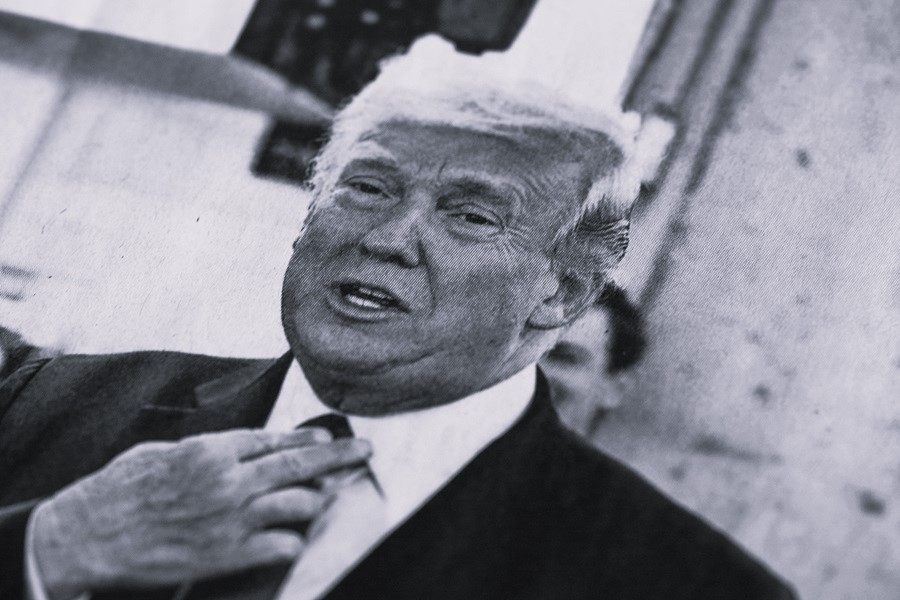Tariffs appear to be the opening salvo of a wider plan to shake up global trade, but is this all a sign of American weakness not strength?
The press usually treats a strong gold price with consternation, largely due to gold’s long history as a hedge against inflation, war, uncertainty and government incompetence. Gold price up means bad things.
The Financial Times remains the newspaper of record with respect to the markets, and as such, the almost hysterical tone of a recent article by Gillian Tett, a usually sober and highly respected senior member of the editorial team, is worthy of note, particularly since she was writing about gold’s recent rally (FT Link).
Her concern comes not so much from the rise in the gold price itself, but its cause, which she identifies as a rumoured plan by the new Trump administration to revalue America’s gold reserves (8,134k tonnes held at $42.22), thus creating a large cash balance at the US Treasury to make America great again.
There is some fire amidst the smoke. Scott Bessent, the Secretary of State for the Treasury, has been quoted as saying that the administration will “monetize the asset side of the US balance sheet for the American people”, and since the assets mentioned are “liquid”, speculation has focused on gold (and perhaps bitcoin, although legal ownership of the ~200k coins the Federal government holds is not clear given the assets are confiscated and may yet be returned to their rightful owners).
A revaluation of gold from its 1973 holding value of $42.22 to a current market price just shy of $3000 would yield the US Treasury some $800b. The proceeds could be earmarked for a sovereign wealth fund (to buy TikTok amongst other things), even though such funds are usually the privilege of creditor nations. (America runs twin deficits, hence the need to ‘manufacture’ the money from a gold revaluation.)
$800b is clearly a big wedge of cash, although not so much in the context of a ~$2 trillion primary deficit and a ~$36 trillion national debt. It isn’t so much the sum of money that is alarming; instead, it is the implications of a gold revaluation to effect this accounting manoeuvre.
For much of the past 50 years, governments and economists have been trying to forget about gold as a monetary metal, hence the usual tropes of it being a pet rock or a barbarous relic. This seems to be a key part of Ms Tett’s concern. The perception of a remonetisation of gold suggests a shift away from a globalised, financialised, unipolar world back to a more fragmented and uncertain one, with all the risks this involves. A shift back to gold is a shift back to a less civilised and less progressive era.
The market hasn’t time for such philosophising. 2025 has seen a strong gold price, as well as a large premium-to-spot in the Comex futures market in the US, which in turn may explain the heavy flow of bullion from London to the US as traders try to arbitrage spot and futures price differences. The cost of borrowing GLD exchange traded fund shares has also spiked, while the Bank of England is reporting huge delays in the delivery of gold. A normal delivery cycle of 2-3 days is now taking up to 8 weeks. This is unusual in the extreme.
While much in the gold market is opaque, there is clearly a dramatic increase in demand for physical gold at present. The idea that this is due to impending Trump tariffs seems a poor explanation. Perhaps people are getting long or covering shorts ahead of a US gold revaluation (the idea Gillian Tett mentions). The more exotic and conspiratorial parts of the gold market are dredging up stories that the US gold reserve has been lent or sold multiple times over, or that Fort Knox is empty, hence the scramble to own metal before a revaluation. This has apparently grabbed Elon Musk’s attention, and he is now urging an audit.
Because numbers, the gold story is grabbing the headlines. Yet far more interesting is the second part of Gillian Tett’s article that brings up a white paper written by Stephen Miran, Trump’s nominee as chairman of the Council of Economic Advisers and senior strategist at Hudson Bay Capital Management (see photo above).
Written in November, the note (Miran’s white paper) explains a possible route for the Trump administration to navigate global trading relations based on two ideas: first, that the dollar is over valued because of its reserve-currency status; and secondly, that America ought to recalibrate its international relations to onshore industry and profit from the global security its military provides.
It explains how tariffs are not only a negotiating tool but also a revenue raising one, and that the US ought to demand of its allies a swap of their current US Treasury holdings for longer-dated ‘century bonds’ at potentially discounted interest rates to fund the US military in its role as global policeman. A failure to comply would lead to high tariffs being imposed. With lower interest rates on longer-dated debt, a weaker dollar would ensue, helping US exports. What it essentially argues is that a tariff policy would be followed by a currency policy, eventually weakening the dollar to the benefit of US industry.
A first example of this policy in action has been Secretary of State Peter Hegseth suggesting not only that Ukraine won’t return to its pre-2014 borders, but also that US troops won’t act as peacekeepers, nor that Ukraine will join NATO, and that subsequent adverse events in Ukraine wouldn’t constitute a violation of Clause 5 of the NATO treaty (which stipulates an attack on one NATO country is an attack on all of them).
Mr Miran’s white paper specifically says that if US allies refuse to pay up but then go on to increase their own defence spending while also being subject to revenue-raising US tariffs, then this is a ‘win’ for the US. The flap in which Mr Hegseth’s speech left European leaders suggests that they are starting to get the message, and that some sort of diplomatic revolution is in the air. Mr Miran even gives it a name – the Mar-a-Lago accord, referencing the Plaza currency accord of 1985 as an analogue.
The tone of Mr Miran’s paper is clearly not only America first, in particular with respect to redressing what he claims is an exorbitant disadvantage of having the reserve currency, but also an adversarial one, defining the world in terms of friends and enemies, or at least those who go along with the US plan and those who go it alone.
Much of the period following the Second World War has seen America promote a globalised and increasingly deregulated commercial world based on the US dollar as the world’s trading and reserve currency. The them-and-us tone of Mr Miran’s analysis hints that if there is to be a change in commerce and currency function at a global scale, it is likely to be on a multipolar basis markedly different from the post-war pax Americana, even if the goal is in part to maintain global dollar dominance.
In this sense, and with the US apparently acting because of perceived disadvantages relating to an over-strong currency (incidentally a major reason for suspending the post-war Bretton Woods system in 1971 which led to a decade of inflation and a massive rally in gold), then one wonders whether the bravado and bullying from Trump is really a mask for US weakness not a reflection of its strength.
For those who’ve watched Bernardo Bertolucci’s classic 1987 film ‘The Last Emperor’, the scene of Emperor Puyi absurdly playing tennis in the shadow of the walls of the Forbidden City as the world outside moved on without him resonates strongly.
In 1945, the US was responsible for half the world’s GDP and had a third of the world’s money in the form of gold. 80 years on, its status is much reduced despite its residual power and importance. It’s hard being a smaller dog in a bigger global fight, and what remains to be seen is if the world still wants to do America’s bidding as it has done in the past.
The US clearly has a debt and deficit problem, as well as an overly-financialised economy which has for decades outsourced and gutted itself in the interests of the short-termism of shareholder gain and financial profit.
Changing this will require massive reforms, and it seems that this is perhaps what Trump et al are trying to do. The stakes are clearly high, and the methods involved may prove to be as controversial and painful for America’s allies as they are for its opponents. The question is whether or not these methods prove to be unsound.
This article was originally published in Market Depth and is republished here with permission.








